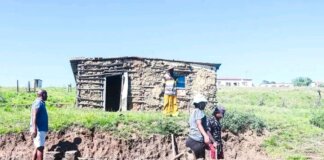This Content is for Subscribers Only
South Africa’s new largest rhino keeper, Wicus Diedericks, has taken his fight for legal rhino horn trade onto a national platform, using the courts to argue that rhino conservation will collapse without it.
With 430 rhinos under his care, he now stands as the world’s biggest private rhino owner following the exit of former leader John Hume, who recently sold his 2,000 rhinos to African Parks to escape the “millions of dollars” in annual protection costs that pushed him to the edge of bankruptcy.
In an interview this month, Rockwood Conservation Founder Diedericks confirmed that looking after rhinos without selling their horns to generate income to protect them from poachers is unsustainable. Like Hume, he is currently looking after rhinos that “don’t pay their way.”
To protect himself from financial ruin, he applied for permission to trade the horns from rhinos in his conservation breeding operation and won. In a landmark 1 November 2025 judgment, the Kimberley High Court ruled that: “In circumstance where the Management Authority is satisfied that the rhino horn comes from a white rhinoceros that was bred for conservation purposes, the Management Authority shall, upon application, issue a permit/certificate to that effect.”
It was the first successful ruling of its kind in South Africa and it opened a long-blocked door for hundreds of private rhino owners.
“I’m about to trade in my rhino horn, but there are questions,” said the world’s new largest rhino keeper.
The biggest breakthrough for him was the court’s confirmation that the UN Convention on International Trade In Endangered Species of Wild Fauna and Flora (CITES) Article 7(5) is part of South Africa’s domestic law and that “therefore my conservation breeding facility will qualify for export permits if we want to export rhino horn.”
But the victory was short-lived. The Northern Cape Province’s Member of the Executive Council for Environment, the same authority that previously refused to grant Diedericks rhino horn trade permits filed an appeal, halting his ability to sell his legally harvested and stockpiled horns. Rhino horn is a renewable resource and can be traded sustainably because it regrows naturally, after being painlessly trimmed or harvested.
“It literally took me years, like five years, to get to this point [High Court ruling permitting him to trade],” he said. “A lot of hours and money went into this.”
Diedericks said many people do not realise that “most of the rhinos in South Africa are now in the hands of private owners or private reserves.” This shift in ownership, he warned, means that rhino conservation must be sustainable or else private owners will be forced to give up their rhinos if they cannot fund their protection. Without rhino horn trade income the consequences will be devastating.
Without government permission to trade legally in rhino horn, South Africa’s rhino populations may decline drastically as custodians abandon the practice and opt for less risky conservation and socio-economic enterprises.
Diedericks confirmed that “there is a growing number of people quitting rhino-keeping” because of escalating risks and costs.
To make matters worse, the government is reportedly struggling to protect rhinos from poachers in its protected areas, such as the iconic Kruger National Park.
“Kruger lost more than 80% of the rhinos in the last 10 years,” he said.
In sharp contrast, privately owned rhino ranches have been quietly successful and now own about two-thirds of the country’s rhino population. South Africa has the world’s largest rhino population. This means the majority of the world’s rhinos are owned by South Africa’s private rhino custodians. This is a little-known conservation success.
“On private reserves, the numbers have been steadily increasing because there’s better security,” said Diedericks. But this success brings a “question about funding” because “70% of all the rhinos in South Africa is now on private reserves.”
Private rhino owners don’t receive any financial assistance from government, for rhino conservation.
“Private rhino owners don’t get any state subsidies, we don’t get any support from donors or NGOs or anything,” he said. “That’s why I lodged the permit application, because we know that a rhino horn is worth something. If we could sell rhino horns, at least we can pay for rhino conservation.”
Meanwhile, Diedericks has rejected the idea that rhino owners are trying to get rich.
“I will barely break even, even if I sell rhino horn on a regular basis.”
Right now, he keeps his 430 white rhinos afloat by subsidising it from other income.
“I have been subsidising it [his rhino conservation initiative] but I cannot sustain it in the long run. And rhinos deserve more,” said Diedericks. He currently pays more than US$1.5 million annually, anti-poaching and other costs.
His journey began on a farm, with a love of wildlife and a decision to “rewild” land originally used for cattle farming. He bought his first rhino in 2013. Two poaching incidents on his rhino ranch hardened his resolve.
“That sparked me to say I’m definitely not going to lose this fight against rhino poaching,” he said.
His family supports him, but even that has limits.
“If it’s not sustainable, you cannot continue with it,” said Diedericks. “You know, that’s why John Hume eventually decided to sell his operation, because it wasn’t sustainable.”
What might Diedericks do if he is ultimately blocked from his new-found hope created by the Kimberley High Court judgment?
His answer is blunt.
“I wouldn’t have any option but to sell the operation, to sell the rhinos, to get rid of them. That’s the reality of most private reserves that own rhinos.”
On CITES’ relevance to wildlife and rhino conservation, he is equally direct.
“Unfortunately, I think it has been captured by a lot of NGOs and the animal rights crowd. At this stage it is not good for conservation. The rhino can pay for its protection and survival. Therefore, we should not deny them that opportunity.”
The warning could not be clearer:
If private rhino owners cannot trade rhino horn legally to finance protection, they will abandon rhino-keeping. If they do, South Africa will lose most of its rhinos. And when South Africa’s rhinos fall, the world’s rhino population will fall with them.
It remains to be seen when CITES and rhino-owning countries will start making decisions that promote rhino conservation.








